MOS Capacitor & MOSFET
Section author: Daryoush Nosraty Alamdary
The purpose of this tutorial is to show how the results of our simulation software (which solves the Poisson and drift-diffusion current equations numerically) compare with analytical equations given in standard text books on MOSFETs. The analytical equations use certain approximations and assumptions which limit their applicability. Nevertheless, in most cases the agreement is very good as demonstrated in this tutorial.
Contents
Part 1: Capacitance-voltage characteristics of a 2D MOS capacitor
In the first part of this tutorial we discuss the capacitance-voltage (C-V) characteristics of the MOS capacitor in a 2D simulation. (For a 1D simulation of the C-V characteristics, see also this tutorial: “Capacitance-Voltage curve of a “metal”-insulator-semiconductor (MIS) structure”). Our MOS has the same dimensions and properties (channel length, doping profiles and gate contact type) as the corresponding MOSFET discussed in Part 2.
Part 2: Current-voltage characteristics of a 2D n-Channel MOSFET
In the second part of the tutorial, we start with the design of the MOSFET based on its 2D MOS capacitor, and then discuss its input and output characteristics and their respective conductances, namely transconductance and channel conductance.
Part 3: Mobility models and pinch-off in a 2D n-Channel MOSFET
In this part we discuss and compare the effect of different mobility models on the output characteristics of the MOSFET and how they affect properties such as pinch-off, saturation, etc.
References
[Goetzberger] A. Goetzberger, M. Schulz, Fundamentals of MOS Technology, In: H. J. Queisser (eds) Festkörperprobleme 13, Advances in Solid State Physics 13, Springer, Berlin, Heidelberg, 309-336 (1973), https://doi.org/10.1007/BFb0108576
[Wu] Y.-C. Wu, Y.-R. Jhan, 3D TCAD Simulation for CMOS Nanoeletronic Devices, Springer, Singapore (2018)
[Sze] S. M. Sze, K. K. NG, Physics of Semiconductor Devices (3rd ed.), John Wiley, New York (2007)
[Brews] J. R. Brews, W. Fichtner, E. H. Nicollian, S. M. Sze, Generalized guide for MOSFET miniaturization, IEEE Electron Device Letters 1, 2 (1980) https://doi.org/10.1109/EDL.1980.25205
[Miura-Mattausch] M. Miura-Mattausch, H. J. Mattausch, N. D. Arora, C. Y. Yang, MOSFET modeling gets physical, IEEE Circuits and Devices Magazine 17, 29 (2001) https://doi.org/10.1109/101.968914
2D MOS Capacitor
Input files:
MOS_CV_5 nmSiO2_5 nmCont_Dop1e16_QM_1D_fine_grid.in
MOS_CV_5 nmSiO2_5 nmCont_Dop1e16_QM_1D.in (nonuniform grid)
MOS_CV_5 nmSiO2_5 nmCont_Dop1e16_QM_2D.in
MOS_CV_5 nmSiO2_5 nmCont_Dop1e16_QM_2D_periodic_x.in (uniform grid along x direction with periodic boundary conditions, quasi-1D simulation)
In this tutorial we illustrate the simulation and analysis of an N-channel MOSFET (Metal-Oxide-Semiconductor Field-Effect Transistor) in 2D as implemented in CMOS technologies and nanodevice fabrication. The first step in simulating the MOSFET is the construction and the simulation of the corresponding MOS capacitor, i.e. the Metal-Oxide-Semiconductor device, which can act as a capacitor on its own, and is an integral part of the MOSFET. The gate contact on this capacitor is the same gate contact as of the MOSFET, and it underlies the same physics in both the MOS and the MOSFET. The 2D sketch of the MOS capacitor is illustrated in the following figure Figure 2.4.462
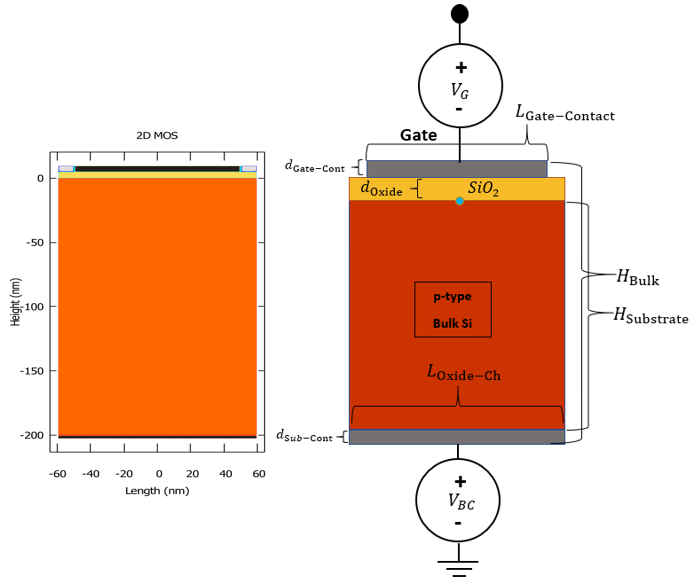
Figure 2.4.462 The geometry of the 2D MOS design, and its equivalent geometry from the output file regions.vtr (colored differently in post-processing).
The blue circle indicates the position of the origin of our
In this tutorial we use a p-doped bulk-Si MOS with a Schottky contact at the gate (instead of a poly-Si contact), and ohmic contact at the substrate.
Therefore, the effect of poly-Si depletion at the gate is not present in either of the devices in order to produce the C-V characteristics of our capacitor, which then is the same MOS device used within the N-Ch MOSFET.
The bulk p-doping level is
Low-Frequency Capacitance
In what follows are the results of our numerical calculations. Concretely, we solve the coupled Schrödinger, Poisson and current equations in two dimensions. We compare our results with the analytic formulas given in standard text books.
The low-frequency capacitance of a MOS capacitor can be measured experimentally with a low frequency signal. In the simple case scenario, the interface trapped charges (charges trapped in the oxide) usually play no role in the capacitance of the device and are not considered in our simulations. Therefore the total capacity of the device is a series connection of the oxide capacitance and the depletion layer capacitance,
The oxide capacitance is the capacitance of the oxide layer, which is independent of the bias, and is simply calculated according to
The depletion layer capacitance is calculated using the charge in the depletion layer as defined in equation (2.4.65),
where
with
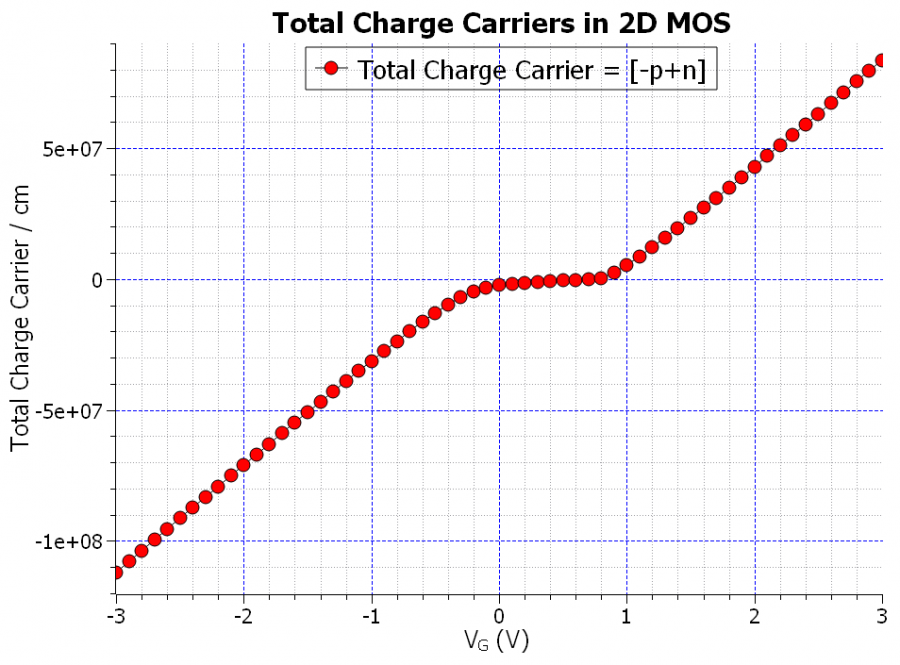
Figure 2.4.463 The total charge carriers per cm of the MOS, integrated in the substrate, vs. the applied gate bias.

Figure 2.4.464 The C-V characteristics of the 2D MOS with
In the above figure the
There are three values which we read from the graph (actually four but since we have the band edges here in the simulation output, we just need three).
The first is the oxide capacitance

Figure 2.4.465 The alignment of conduction and valence band edges with respect to the Fermi levels of the 2D MOS under the flat-band condition along a one-dimensional slice along the y direction. (The lowest conduction band edge is labeled with X.
The bias voltage that results in a band structure in the figure Figure 2.4.465, is called the flat-band voltage
The
Calculating this expression for our system, the surface potential amounts to
The height of the Schottky barrier used here, however, has to reflect the metal-SiO:sub:2 interface barrier, and not the metal-semiconductor barrier.
This barrier depends on the metal and its work function that is used, and is therefore different for different metals.
It is also mentioned in [Wu], that “the work function of the metal gate has to be properly defined in order to achieve the expected threshold voltage
The Schottky Barrier, Doping Concentration, Depletion Region
In the following part we look at a set of figures, which illustrate various parameter changes, which then lead to variations in the three important values which we want to read from the C-V curve. First would be the threshold voltage, and the flatband voltage, both of which could be influenced by the height of the Schottky barrier, and the doping concentration in the bulk-semiconductor, as figure Figure 2.4.466 illustrates:

Figure 2.4.466 The comparison of the C-V characteristics of the 2D MOS for varying Schottky barrier and the substrate doping concentration, and their effects on the threshold voltage (vertical blue lines), and the flatband voltage (vertical red lines)
As it could be seen in the above figure Figure 2.4.466, both the barrier height and the doping concentration shift the threshold voltage
In the next set of figures we see, how changing the charge integration region can affect the C-V curve, which then would answer why the

Figure 2.4.467 The comparison of the C-V characteristics of the 2D MOS for varying the width of the charge integration region.
And figure Figure 2.4.468 shows the C-V curve of the MOS capacitor for a charge integration region of

Figure 2.4.468 The comparison of the C-V characteristics of the 2D MOS for varying the width of the charge integration region.
Now it seems that the value of the flatband capacitance
which turns out to be
region{
rectangle{ # Si Charge Carrier Integration Zone
x = [-$L_Oxide_Ch/2 , :remove_enter:
$L_Oxide_Ch/2]
y = [-$H_Substrate, 0]
}
binary{
name = "Si"
}
integrate{
electron_density{} # n-charge carriers
hole_density{} # p-charge carriers
label = "Si_Substrate"
}
}
The total charge is then
Appendix: 2D MOS
The MOS capacitor is a 2D device in its correct form for simulations (with the optional 3rd dimension if need be…). The width of the substrate needs to be somewhat larger than the channel length, so that the depletion layer charges have enough space to expand, also the boundary conditions have to be set to non-periodic in the simulation. That is because even though the channel length is set by the length of the gate-contact, and the inversion layer is bounded by this length, this is not the case for the charges in the depletion layer. Figure Figure 2.4.469 illustrates this phenomenon:
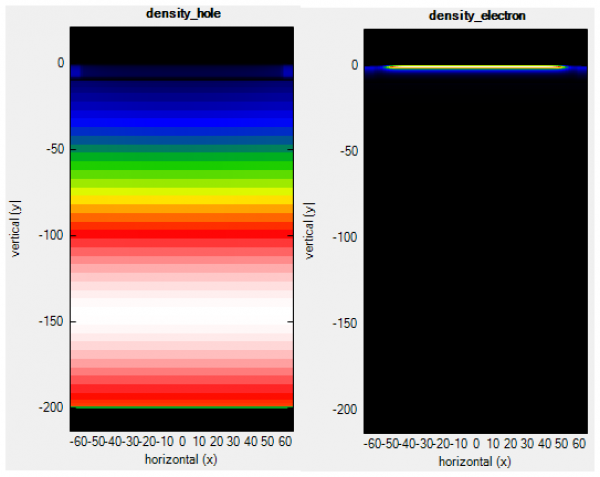
Figure 2.4.469 The spatial distribution of charge carriers (electrons) in the inversion layer during inversion, compared to the ones (holes) in the depletion region during depletion.
If we set the substrate width to the length of the channel, which basically would mean that the MOS could also be simulated in 1D, the C-V curve would look like the following in figure Figure 2.4.470
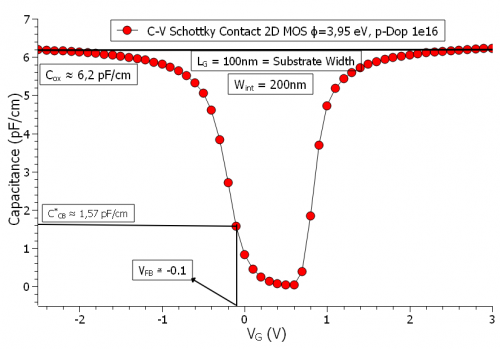
Figure 2.4.470 The C-V curve of the quasi 1-D Simulations of the MOS (this is when we set the length of the oxide and the channel-length equal in a 2D simulation and set the boundary condition in x-direction as periodic).
As seen in the C-V curve, not only the oxide capacitance
With regards to the surface potential
output{
section1D{ # output a 1D section of the simulation area (1D slice)
name = "surface_potential" # name of section enters file name
x = 0
range_y = [-0.2, 0.0] # 1D slice at x = 0 through the middle of the channel
# however limited to the range in y
}
}
Using the post-processing in the template, one can then construct a curve, which should look like the one shown in figure Figure 2.4.471

Figure 2.4.471 The surface potential, at the semiconductor-oxide interface
Such a curve would go through the origin for an ideal MOS device, however depending on how the electrostatic potential is calculated at the contacts, this curve could go higher or lower on the y-axis. The transition from accumulation to strong inversion of the total capacitance happens basically in the region of the potential, where the line is drawn, for which
The last remark regarding the capacitance of the MOS could be that, even though the classical formula of parallel plates capacitor is also here applied to the oxide capacitance, in small dimensions and in few nanometer regime, other effects such as tunneling current, and thermionic emissions could play a significant role.
Additionally, since the quantum mechanical charge distribution distances itself from the semiconductor-oxide interface (as we shall see in the inversion layer comparison of the MOSFET), these effects would significantly reduce the maximum capacitance of the MOS.
As we could see from the C-V curve the flatband capacitance is less than
2D N-Ch MOSFET
Input files:
nMOSFET_2D_Dop-16-20_Schottky_noQM.in
nMOSFET_2D_Dop-16-20_Schottky_QM.in
nMOSFET_2D_Dop-16-20_Schottky_QM_decomposition.in
The MOSFET is a transistor, which is made of a MOS capacitor in the middle and a source-drain channel for conduction. The channel of the MOSFET, which is probably the most important aspect of the MOSFET, extends from source to drain, and is created by a charge carrier inversion layer in the MOS. In this tutorial we simulate an N-channel MOSFET based on the proposed model in [Wu]. As parameters, we vary the oxide thickness, channel length and the doping profiles and investigate how these changes affect the simulation results. These quantities are defined as follows:
The overall geometry of the simulated N-Ch MOSFET in this tutorial is illustrated in the following figure Figure 2.4.472:

Figure 2.4.472 The geometry of the N-Ch MOSFET design, and its corresponding geometry from the output file user_index.vtr. The individual regions can also be found in the output file regions.vtr.
The drain-source current of the MOSFET is given by equation (2.4.70)
where the threshold voltage
For the input characteristics, this equation becomes a function of the gate voltage
Input Characteristics
Using the Masetti mobility model, we have calculated the input characteristics of the MOSFET classically, which is shown in figure Figure 2.4.473 on a linear scale,

Figure 2.4.473 The input characteristics of the N-Ch MOSFET calculated classically with Masetti mobility, showing the position of the threshold voltage
and in figure Figure 2.4.474, on a logarithmic scale:
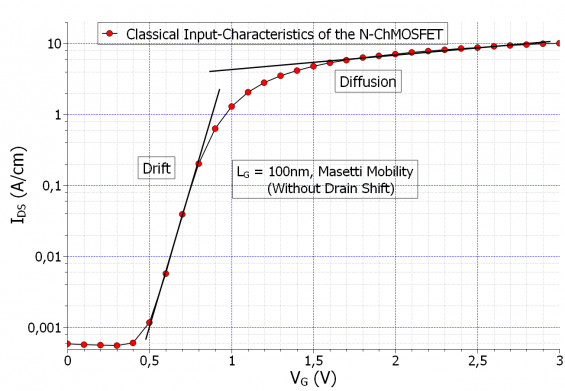
Figure 2.4.474 The input characteristics of the N-Ch MOSFET calculated classically with Masetti mobility, showing the drift and diffusion current regions on the logarithmic scale.
The above input characteristics were calculated without the shift in the drain contact.
This could modify the results in a certain way that is worth noting.
More on this could be found in the Appendix: MOSFET. According to [Sze], the extrapolation of the linear region meets the x-axis at
compared to
However the input characteristics could also be calculated quantum mechanically, since we only have to define the inversion layer region as a quantum region. The prediction is that the charge carrier inversion layer would shift slightly away from the oxide, since the wave function amplitude would have to fall to zero at the oxide-semiconductor interface. This phenomenon is illustrated in figure Figure 2.4.475

Figure 2.4.475 The comparison of the charge inversion layer of the N-Ch MOSFET calculated classically (right), and quantum mechanically (left) at
The following set of curves in figure Figure 2.4.476 are the comparison of the input characteristics calculated classically and quantum mechanically, with and without quantum decomposition method:
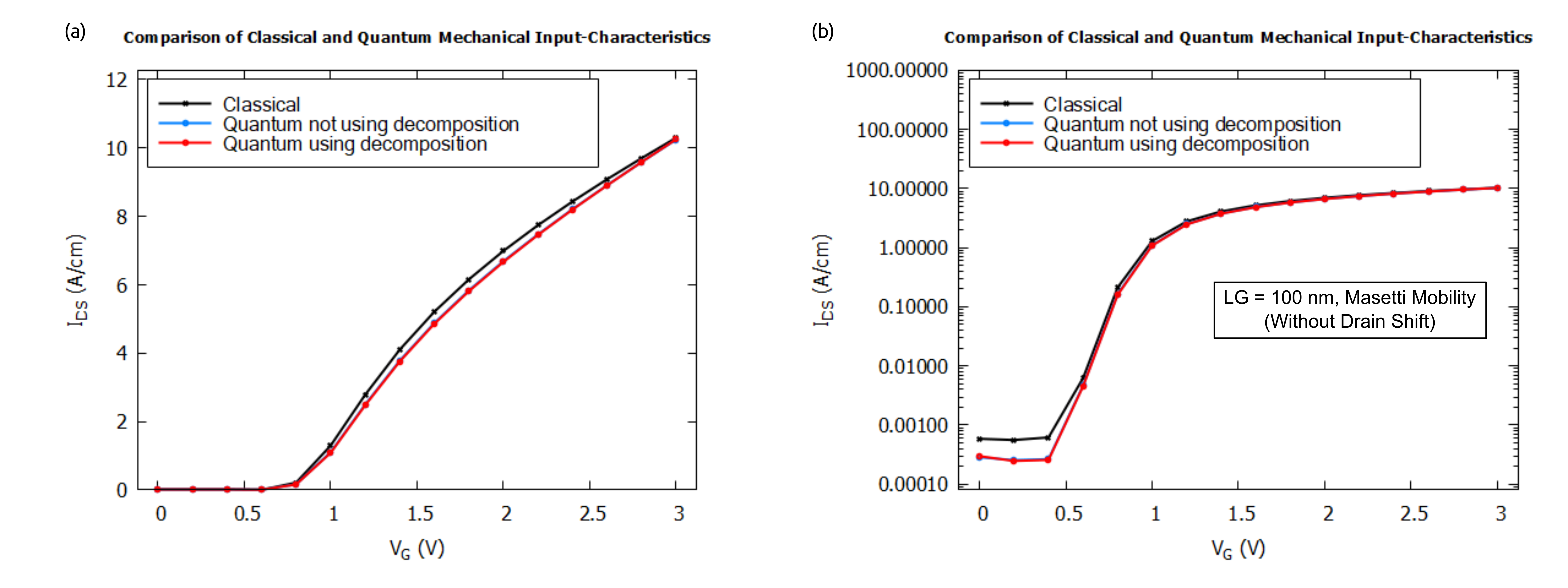
Figure 2.4.476 The comparison of the input characteristics of the MOSFET calculated classically and quantum mechanically wit (a) linear and (b) logarithmic scales.
As the simulations shows, there is a slight difference in the input characteristics, most importantly for the leakage current, the one below the threshold voltage. It turns out to be lower for the quantum mechanical input characteristics. Moreover, comparison above shows that using the quantum decomposition method triggered by a keyword quantize_y{} gives almost the same IV curves as in the case of solving the Schrödinger equation in 2D while notably reducing time and memory required for the computation.
Output Characteristics
The output characteristics of the MOSFET is the I-V characteristics of the drain current

Figure 2.4.477 The output characteristics of the N-Ch MOSFET calculated classically with Masetti mobility, showing the linear and the saturation regions of the output characteristics.
The slope of the black line which covers the linear region of all the curves, can be used to calculate the channel specific resistivity.
Now, if we take the width of the MOSFET to be
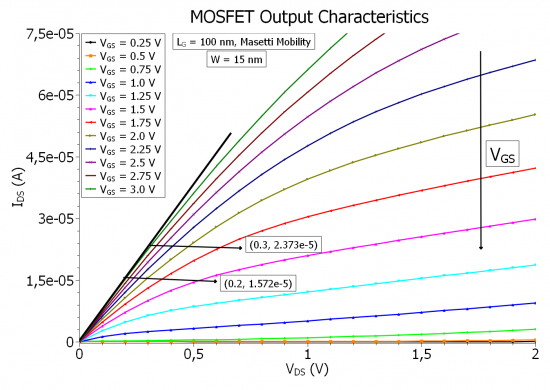
Figure 2.4.478 The output characteristics of the N-Ch MOSFET calculated classically with Masetti mobility, showing the linear and the saturation regions of the output characteristics for a width of
From the readings on the curve we can estimate the specific channel resistivity,
As mentioned before, the output characteristics can be divided into two regions, the ohmic region and the saturation region.
The transition to the saturation region happen at the
This value obviously is meaningful for
and plotting this current over the output characteristics, the curve crosses each
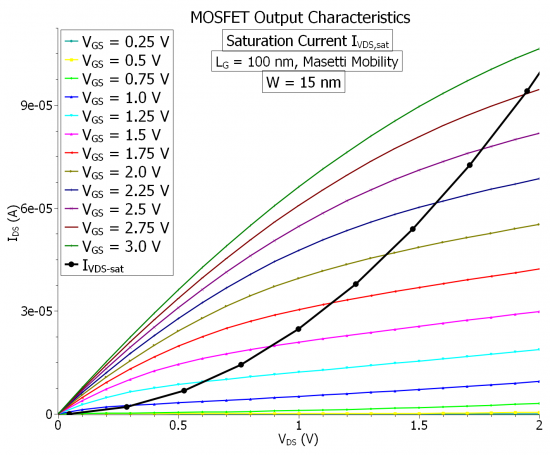
Figure 2.4.479 The output characteristics of the N-Ch MOSFET calculated classically with Masetti mobility for a width of
If we take the effective mobility to be field-independent (which is the case in our simulations), the above
From the fit parameter estimate, and the rest of the known parameters, we can however estimated the effective mobility
The calculated bulk mobility from the simulations is given to be
Transconductance and Channel Conductance
In many cases, a MOSFET is used for signal amplification, as opposed to switching function, which is the case in CMOS, and digital logic circuits.
For this purpose quantities such as transconductance and channel-conductance become important.
The transconductance is defined as the derivative of the output current
Figure Figure 2.4.480 shows the tranconductance curve and its maximum value:
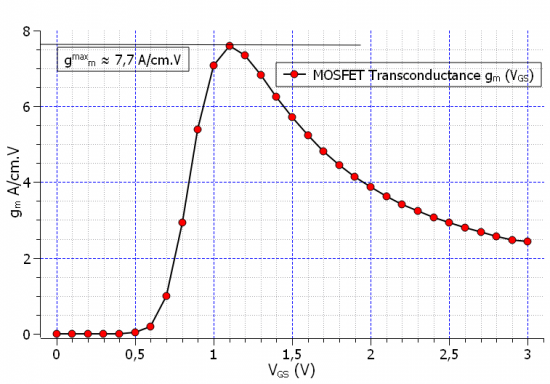
Figure 2.4.480 The transconductance of the MOSFET as a a derivative of the source-drain current
The maximum value of the transconductance read from the curve amounts to
which amounts to
which is in turn a function of the gate voltage

Figure 2.4.481 The channel conductance of the MOSFET as a derivative of the source-drain current
Note that all of the curves in the above figure are from the same family. they are only stretched and displaced with respect to each other since the arguement
Finally we have for
which would be straight line with respect to
Comparison of Different Mobility Models
The effect of the correct mobility model for the simulations of such devices as MOSFETs cannot be overstated. It is an established fact, that the best mobility models used for simulating the current transport in the channel are those that are field dependent, and therefore are modified along the channel as a result of the perpendicular (and also parallel) field. The simplest of these models is the velocity saturation model which sets a maximum value for the drift velocity as the function of the field, and with that the mobility is limited by the maximum velocity. There are of course also more complicated models such as the enhanced Lombardi model, or inversion layer mobility models, which also take into account the scattering of the charge carriers at the semiconductor-oxide interface. These are very specialized models, specifically designed for the simulation of such devices as MOSFETs, and other field effect devices, and are implemented in specialized commercial TCAD tools used by industry. Here we are limited to the already implemented mobility models, which hopefully in the near future will expand. These are the Masetti model, Arora model, Minimos model, and constant mobility model. Figure Figure 2.4.482 illustrates the effect of different mobility models on the input characteristics of the MOSFET:
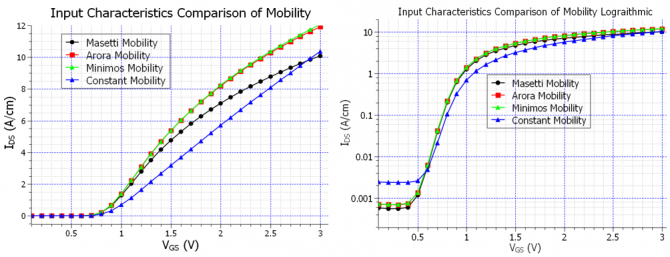
Figure 2.4.482 The input characteristics of the MOSFET calculated classically with different mobility models, in normal and logarithmic scales.
In the above curves, interestingly enough the Masetti model seems to reach the saturation much sooner than the other ones, and the constant mobility model seems to be a straight line, even though the value of the constant mobility is much lower in the inversion layer than the rest of the mobility models (
The following figure Figure 2.4.483 shows the output characteristics calculated with the constant mobility model set at
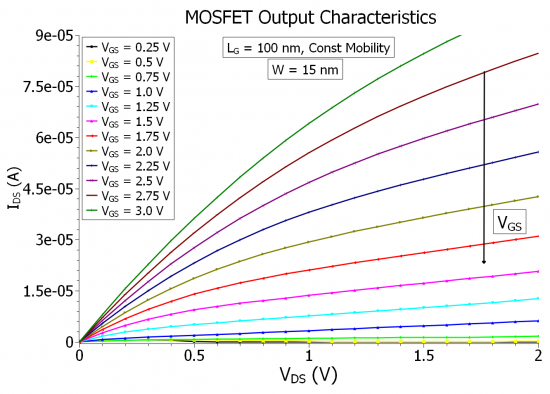
Figure 2.4.483 The output characteristics of the MOSFET calculated classically with the constant mobility model, taking the width
We can now compare this to the Masetti mobility as the example of doping dependent models. Figure Figure 2.4.484 shows the comparison for a selection of the

Figure 2.4.484 The comparison of the output characteristics of the MOSFET calculated classically with constant mobility and Masetti models, for a selection of gate voltages, and the width
As the curves suggest, the difference is negligible for very high and very low gate voltages.
The difference becomes significant only for
Furthermore, it is worth mentioning, that a good mobility model for the inversion layer in the MOSFET should have two field dependencies, one being the perpendicular field originating from the gate, and the other one the parallel field coming from the source-drain bias. The velocity saturation method, which has recently been implemented would only have one of these components, namely the parallel field dependency, and since it is still at the experimental level, we did not put any results simulated with that. However the implementing velocity saturation would have a distinguishable effect on the output characteristics of the short channel MOSFET.
Channel Length Modulation and Pinch-Off effect
nMOSFET_2D_Dop-16-20_Schottky_Class_VG-2.0_Pinch-off.in
One last effect that is worth talking about in the context of the output characteristics, is the pinch-off effect, i.e. the effective shortening of the channel length, which is known as the channel length modulation.
It is said that the pinch-off effect steps in at the onset of saturation
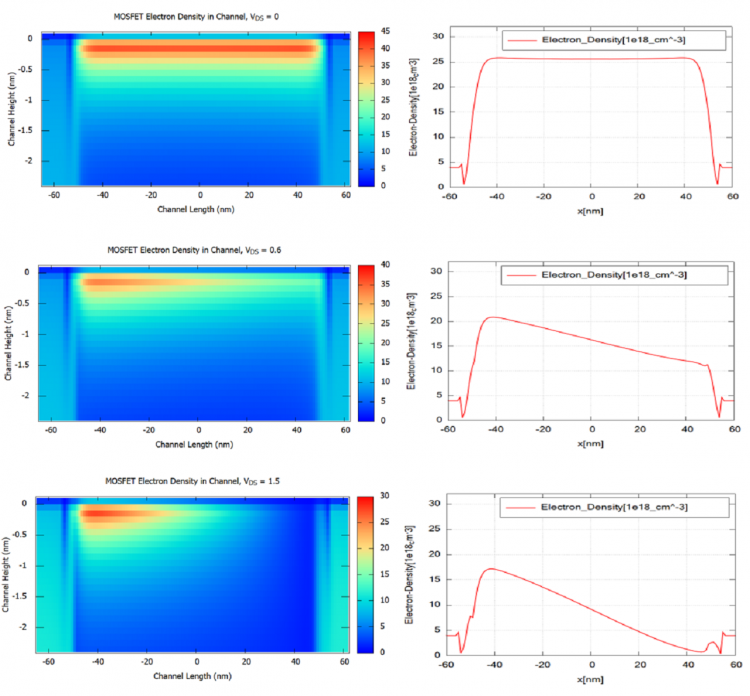
Figure 2.4.485 The comparison of the electron density distribution in the channel for
Then the saturation current equation takes the following form:
with

Figure 2.4.486 The illustration of the shortening of the effective channel length due to the expansion of the drain and source depletion widths.
Using the built-in potential of the p-n junction at the source and drain
From which then results the effective channel length (as also illustrated in figure Figure 2.4.486), as follows:
However, this analysis has an indirect implication with regards to the channel length. Namely, for given source and drain depletion regions there is a minimum channel length. And indeed there is such a consideration, which is said to separate the long channel scenario from the short channel one, meaning a channel above this minimum length is considered a long channel (and not a short channel), and the above considerations apply only to long channel MOSFETs. As we will later see there are also other effects and considerations which will apply to the case of short channels (together known as the short channel effects). The minimum channel length for the long channel case is then given by the following empirical formula in (2.4.78),
where
If we take
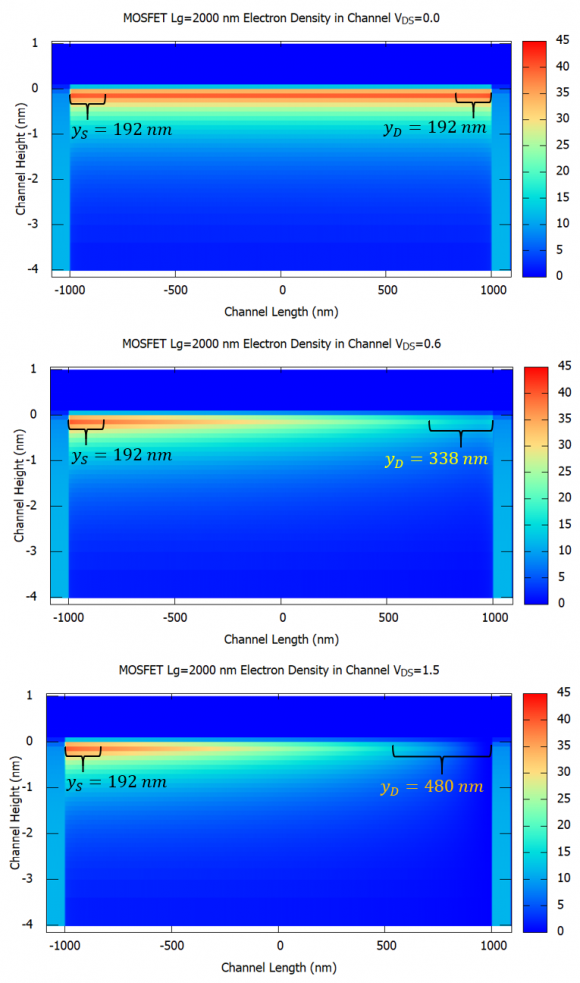
Figure 2.4.487 The illustration of the pinch-off effect, and the channel length modulation, in the N-Ch MOSFET with a channel length of
So therefore, according to the calculations in figure Figure 2.4.487, the effective channel length should be
Short Channel Effects, DIBL and Punch-Through
So as we established in the previous section, our MOSFET, with a

Figure 2.4.488 The illustration of the drain induced barrier lowering (DIBL) in
In order to recognize the punch-through effect, the sweep of the gate-length should be performed at high drain-source voltages (for example

Figure 2.4.489 The punch-through effect for a set of channel lengths in MOSFET apparent in the input characteristics (calculated with minimum density of
As it could be seen in Figure 2.4.489, the MOSFET with gate-length of
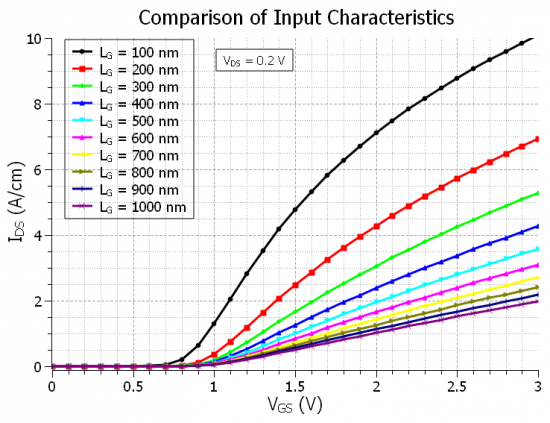
Figure 2.4.490 The effect of increasing the channel length on the input characteristics at
So therefore we expect, that our input characteristics will be the same for a channel length of
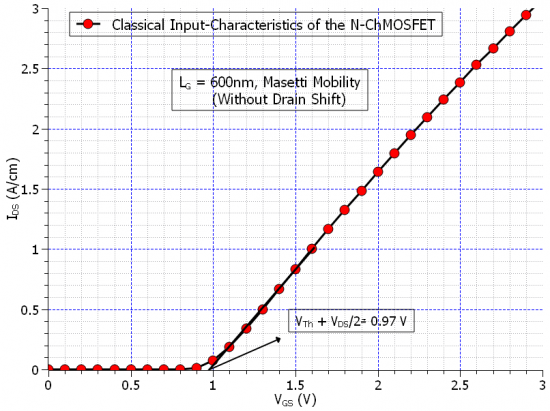
Figure 2.4.491 The input characteristics of the long-channel
From which it could be concluded, that the threshold voltage is
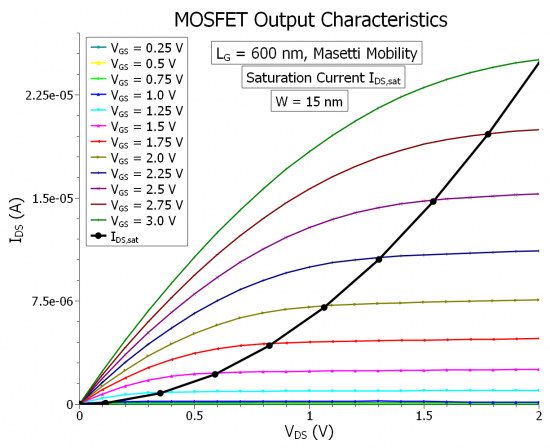
Figure 2.4.492 The output characteristics of the long-channel
As we can see in the above figure, the quadratic curve fits the output current curves exactly at the proper voltage point, which is
The calculated mobility from the simulation is once again
Appendix: MOSFET
In the last section we found out, from the comparison of the input characteristics at high drain-source voltage
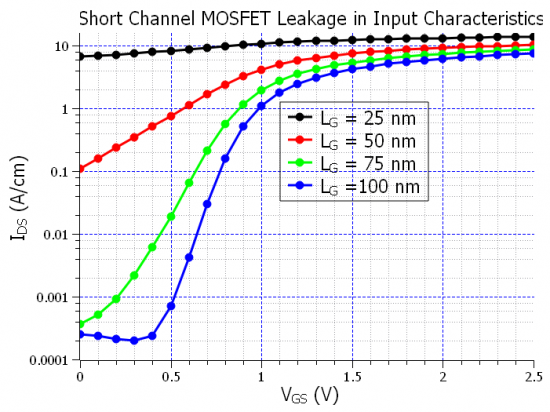
Figure 2.4.493 The comparison of input characteristics of the N-Ch MOSFET calculated quantum mechanically with the Masetti mobility, showing the leakage current in the input characteristics.
As the above input characteristics curves show, for gate-length below
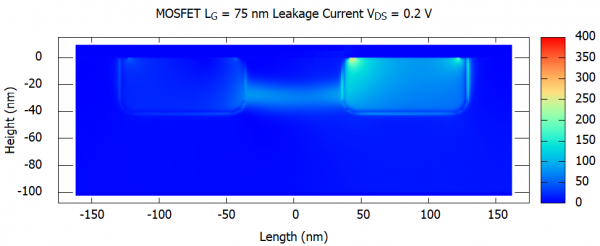
Figure 2.4.494 The norm of the leakage current in
If we even consider the
classical{
...
...
energy_distribution{
min = -0.5
max = 1.0
energy_resolution = 0.001
only_density_quantum_regions = yes
}
energy_resolved_density{
min = -0.5
max = 1.0
energy_resolution = 0.001
only_density_quantum_regions = yes
output_energy_resolved_densities{}
}
}
But to be able to see the quantum mechanical effects, lets us first take a look at the classical energy resolved densities in the channel and the source-drain doping regions (for that the only_density_quantum_regions flag has to be set to no in the energy_resolved_density{} group).
The classical energy resolved densities are shown in figure Figure 2.4.495:
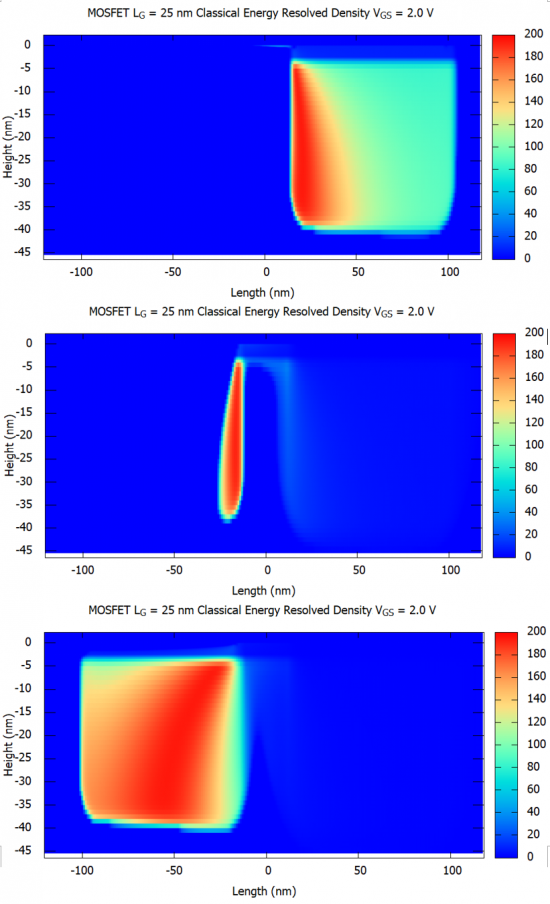
Figure 2.4.495 The classical energy resolved density in the
Now let us look at the same energy resolved densities in the MOSFET source and drain region, obtained using the quantum mechanics alone:
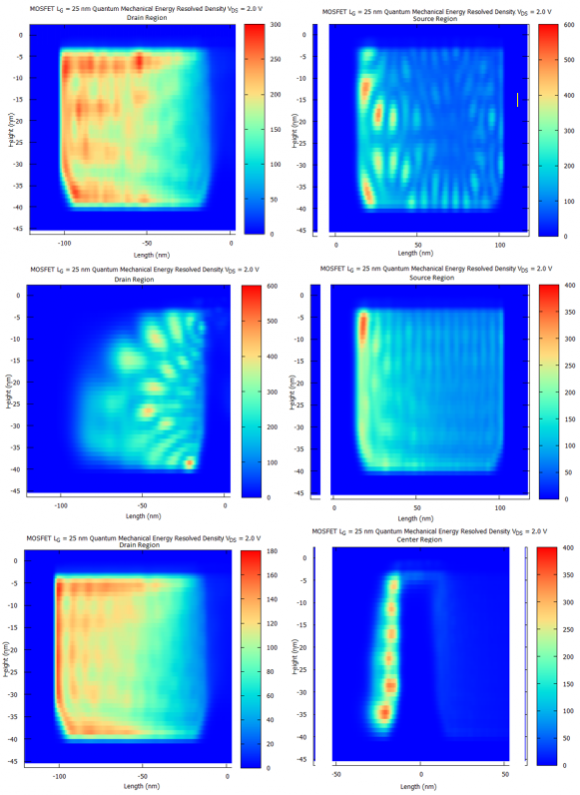
Figure 2.4.496 The quantum mechanical energy resolved density in the MOSFET source and drain regions, showing spacial quantum confinement at discrete energy levels.
In the above figure we can clearly see that compared to the classical density, the quantum mechanical density indicate quantum confinement in the source drain doping regions. Furthermore, as we shall see in figure Figure 2.4.497, also the density in the inversion layer shows quantum confinement for different discrete energy levels:
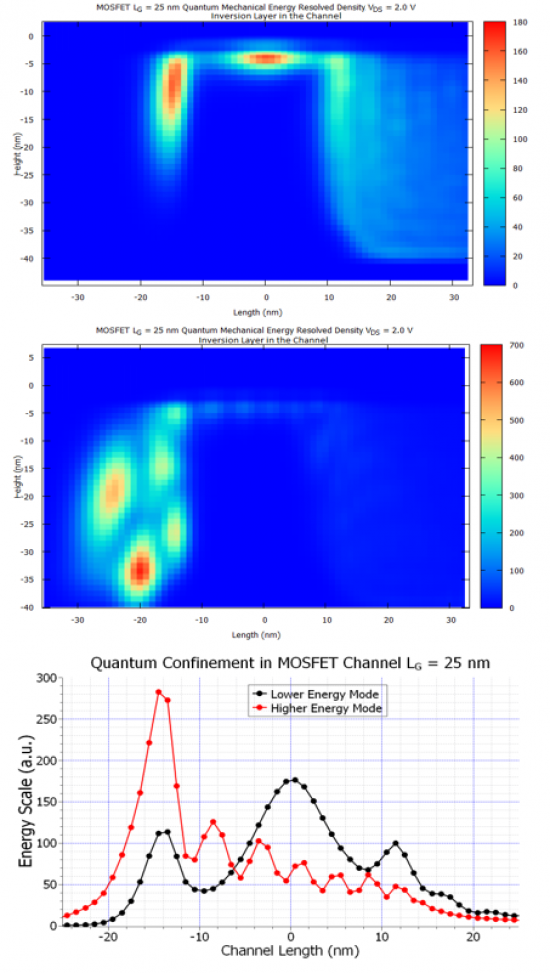
Figure 2.4.497 The quantum mechanical energy resolved density in the inversion layer of the MOSFET-channel, at two different energy levels, showing the standing wave pattern, which indicates quantum confinement.
As we can see there is clearly two different quantum confined modes in the inversion layer of the channel for this MOSFET.
With regards to the issue of convergence for the output characteristics, the convergence parameters become very relevant, since for the wrong set of parameters, the simulations may very well never converge and if so might take a significant amount of time.
The key parameter to keep in mind is the ‘’alpha_fermi’’ parameter in current-poisson{ } calculations, which would decide the fate of the calculations.
This parameter needs to be chosen corrently, and also since it will be dynamically reduced, the alpha_scale parameter also need to be set appropriately, with a relatively small alpha_iterations (default is 1000, which is very high!!!), so that a quick adjustment can be achieved if the parameter is too large.
One also needs to significantly increase the number of iterations from the default 100, to a few thousand.
This so called under-relaxation parameter for the quasi-Fermi level is important due to the fact that it decides the volume of the search for the solutions.
Last update: nn/nn/nnnn